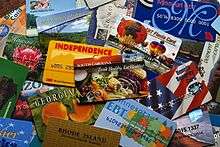CalFresh

CalFresh is the California implementation of the federal Supplemental Nutrition Assistance Program (SNAP), formerly known as the Food Stamp program, which provides financial assistance for purchasing food to low-income California residents.
Eligibility and benefits
Generally, net income after CalFresh-specific deductions must not exceed 100% of the federal poverty level, while gross income before these deductions may not exceed 200% of the federal poverty level.[1] For example, 200% of the 2016 federal poverty level for a household of 3 would be $40,320 per year.[2] For example, a household of 3 would be an applicant living alone with their 2 children. There also *might* be requirements relating to citizenship/immigration status, asset limits, employment, and other issues.[1] Recipients of the State Supplementation Program (SSP or SSI/SSP), also known as the SNAP cash-out program, are ineligible for SNAP/CalFresh.[3]
As of October 1, 2016, an abbreviated table of benefit issuance amounts based on household size and monthly net income for the FFY 2017 was:[4]
| Monthly "net" income | Household size | |||||
|---|---|---|---|---|---|---|
| 1 | 2 | 3 | 4 | … | 10 | |
| 0-0 | 194 | 357 | 511 | 649 | 1461 | |
| … | ||||||
| 201-203 | 133 | 296 | 450 | 588 | 1400 | |
| … | ||||||
| 591-593 | 16 | 179 | 333 | 471 | 1283 | |
| … | ||||||
| 1334-1336 | [16] | [16] | 110 | 248 | 1060 | |
| … | ||||||
| 2021-2023 | [16] | 42 | 854 | |||
| … | ||||||
| 4097-4100 | 231 | |||||
Administration
CalFresh is administered jointly by the California Department of Social Services and the welfare departments of the 58 counties of California, while the underlying Supplemental Nutrition Assistance Program (SNAP) is a federal aid program administered by the US Department of Agriculture.
The Statewide Automated Welfare System (SAWS) is the county-managed public assistance eligibility and enrollment system, e.g., the case management system for county eligibility staff providing CalWORKs, Welfare to Work, CalFresh, Medi-Cal, Foster Care, Refugee Assistance, County Medical Services Program, and General Assistance/General Relief.[5] Counties are organized into three SAWS consortia (joint powers authorities): C-IV (C4Yourself), WCDS (CalWIN), and Los Angeles County's LEADER Replacement System (LRS).[5]
Federal law mostly consists of the Food Stamp Act (7 U.S.C. § 2011 et seq.), and state law mostly consists of California Welfare and Institutions Code (WIC) Division 9, Part 6, Chapter 10 (WIC § 18900 et seq.). Federal regulations are codified in Code of Federal Regulations (CFR) Title 7 (7 C.F.R. 271 et seq.) and state regulations are not part of the California Code of Regulations (CCR) but are separately published as the CDSS Manual of Policies and Procedures (MPP) and are "available for public use in the office of the welfare department of each county".[6] The MPP includes the Eligibility and Assistance Standards Manual (MPP divisions 40-50, 81-82, 89-91), the Food Stamp Manual (MPP division 63), and the Electronic Benefit Transfer System Manual (MPP division 16). In addition to this manual, the CDSS often communicates policy direction to counties through periodic All County Letters (ACLs), All County Information Notices (ACINs), and business letters.[7]
See also
References
- 1 2 "Eligibility and Issuance Requirements". California Department of Social Services. Retrieved 25 December 2016.
- ↑ "Federal Poverty Level (FPL)". HealthCare.gov.
- ↑ 7 U.S.C. § 2015(g)
- 1 2 https://www.sccgov.org/ssa/charts/ch-fs.pdf
- 1 2 County Welfare Directors Association. "Statewide Automated Welfare System – California's Most Successful Automation of Human Services Programs".
- ↑ Part 1, Division 2, Title 22 of the California Code of Regulations
- ↑ "How the Food Stamp (CalFresh) Program is structured". foodstampguide.org. Legal Services of Northern California. Retrieved 18 January 2013.
External links
- GetCalFresh.org from Code for America
- BenefitsCal.org from the County Welfare Directors Association
- C4Yourself system from C-IV
- CalWIN system from WCDS
- YourBenefitsNow! system for Los Angeles County
- Official website
- Food Stamp Manual (changes)
- UC CalFresh Nutrition Education Program
